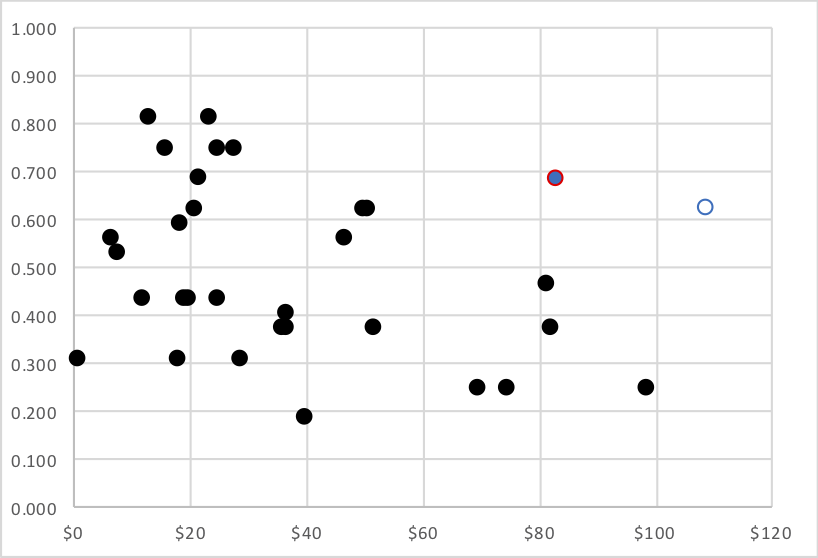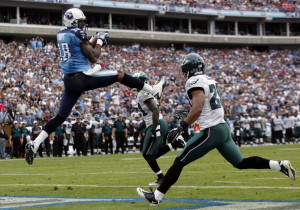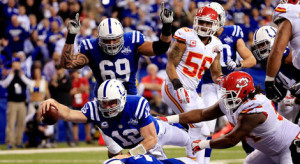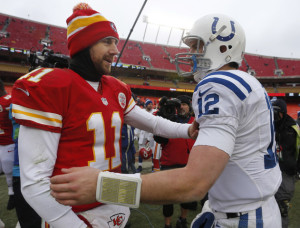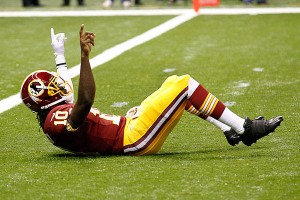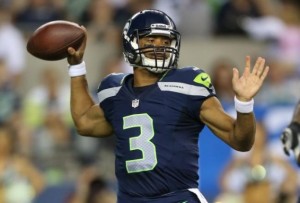The graph below shows each team in the NFL. The X-Axis shows how much effective cap space in 2019 each team has, as determined by Over The Cap. The Y-Axis shows each team’s winning percentage in 2018. The Colts, with over $100M of effective cap space in 2019, and a 10-6 record in 2018, stand out from the pack; I’ve colored their dot in white and blue. The Houston Texans, third with $83M (the Jets are second with $98M) and an 11-5 record last year, do too; I’ve colored their dot in blue and red.
This week at the New York Times, I look at a pair of teams that have gone from 0-2 to 3-2, a statistical rarity, and a league-wide passing trend:
About three weeks ago, you probably heard some variation on the following statistic: Since 1990, only 12 percent of teams that started 0-2 ended up making the playoffs. Seven teams started 0-2 this season, but two of those have rebounded with three-game winning streaks.
Andrew Luck leads the N.F.L. in passing yards and touchdowns while posting a 100 passer rating. His Colts lead the league in points scored, and Indianapolis has the second-best point differential in the N.F.L., behind the San Diego Chargers. The Colts, division champions in 2013, are back on top of the A.F.C. South, tied with the Houston Texans for the division’s best record. As a result, it is probably hard to even remember that only three weeks ago, the Colts were one of those struggling 0-2 teams.
The A.F.C. South was the worst division in football last year, and not much has changed in 2014. In interdivision games, A.F.C. South teams are 5-11, the worst record of any division. That is one of the biggest reasons the Colts were able to jump from last to first place so quickly. Indianapolis has feasted on its poor division.
You can read the full article here.
During the 2013 offseason, I wrote 32 articles under the RPO 2013 tag. In my Predictions in Review series, I review those preview articles with the benefit of hindsight. Previously, I reviewed the AFC West and the NFC West. Today, the AFC South, beginning with a straightforward case in Tennessee.
Can Kenny Britt become the next great wide receiver?, July 9, 2013Spoiler alert: Kenny Britt did not become the next great wide receiver, at least in 2013 (apparently, I still can’t quit him). Britt is an easy player to fall in love with, if you ignored the warning signs. He was just 20 years old when he played in his first NFL game in 2009. In 2010, he led all players in yards per route run according to Pro Football Focus, but his raw numbers underhwlemed because the Titans were a run-heavy team and Britt missed 30% of the season with a hamstring injury. In 2011, he matched his elite YPRR production, but a torn ACL/MCL tear ended his season after 94 pass routes.
He struggled in 2012, but I was willing to write that off due to recovering from the ugly knee injury, additional hamstring and ankle injuries, and a first-year starter in Jake Locker. That set up 2013 as a season where I thought Britt had great breakout potential. I interviewed Thomas Gower, of Total Titans and Football Outsiders, and asked him his thoughts. Gower was more pessimistic than I was about Britt, and for good reason.
As it turned out, Britt never seemed quite right mentally (in more ways than one); he struggled with drops and was eventually dropped behind Justin Hunter and Kendall Wright on the depth chart. He finished the year with 11 catches for only 96 yards and no touchdowns. In late December, Britt said he would definitely be a #1 wide receiver somewhere in 2014, which means I’m susceptible to falling into the Britt trap again. [continue reading…]
Of course, Andrew Luck had an incredible game, too, even if it wasn’t necessarily as efficient. Luck went 29/45 for 443 yards and 4 touchdowns to counter his 3 interceptions, rushed for 45 yards, and recovered a Donald Brown fumble and ran it in for the touchdown.
Which made me wonder: where does this game rank among the greatest quarterback battles? To make life simpler, I’m only going to look at passing statistics, although obviously both players added some value on the ground. Smith averaged 9.23 Adjusted Net Yards per Attempt, defined as (Passing Yards + 20*TD – 45*INT – Sack Yards) divided by (Pass Attempts + Sacks). The NFL average in 2013 was 5.87 ANY/A, which means Smith produced 3.36 ANY/A over average. And, since he had 48 pass attempts (including sacks), that means Smith provided 161 yards over average.
Luck’s averages were hurt by the three interceptions, but he still produced 8.23 ANY/A and therefore 2.41 ANY/A over average. That means, over his 46 dropbacks, he produced 111 yards of value over average. So where does that mean this game ranks among all playoff games since 1970? My initial thought was to simply add the two value over average numbers, but that ended up producing a list dominated by great games by one quarterback. To counter this, I decided to only look at games where both quarterbacks were above average and to instead take the Harmonic Mean of their values. This wound up producing a pretty good list, and it places Luck/Smith at #9. [continue reading…]
As best as I can surmise, there are three primary reasons why Harrison shouldn’t be selected in 2014. Two of those reasons can be addressed rather easily, but let’s start with the more complicated issue to analyze.
Harrison’s numbers are inflated because of Peyton Manning
Jerry Rice is the greatest wide receiver of all time. Rice was probably better at his position than any football player has ever been at theirs. Rice might be the most dominant sportsman of his generation. Rice probably isn’t in the discussion of greatest athletes in the history of mankind, which is about the only negative thing I’m willing to say about him. All of that is important background to say, being worse than Jerry Rice is not a negative, but just a fact of life as a wide receiver.
[continue reading…]
By all accounts, this was an underwhelming quartet of games played on The Best Weekend in Football. Last year, the division round gave us an incredible Russell Wilson comeback where the Seahawks scored three fourth quarter touchdowns before falling short against the Falcons and the Peyton Manning–Joe Flacco–Rahim Moore classic. Seattle won this year but in boring fashion, and Broncos fans undoubtedly prefer this year’s rendition of Neutral-Zone-Infraction to last year’s heartbreak. In 2011, the 9-7 Giants pulled off the rarest of upsets: outclassing the 15-1 Packers and winning a game as huge underdogs while managing to look like the better team in the process. The day before, Alex Smith lead the 49ers in a home upset over the Saints in one of the more exciting playoff games of our generation. In 2009 and 2010, the brash Jets won road games as heavy underdogs in convincing fashion against the Chargers and Patriots. This was the halcyon era of the Mark Sanchez–Rex Ryan Jets, also known as years 3 and 2 Before The Buttfumble. In 2008, the Ravens (over the Titans), Eagles (Giants), and Cardinals (Panthers) all won as road underdogs. The year before, the Giants shocked the Cowboys before that was our Tony Romo-adjusted expectation, and the Chargers won as 11-point underdogs in Indianapolis preventing a Tom Brady–Peyton Manning upset (no such road bump this year).
In some ways, the results this weekend were a good thing. Perhaps we will remember this as the year the division round of the playoffs felt like eating a salad – a bit unsatisfying at the time, but better for us in the long term. No one would complain about seeing more Andrew Luck — actually, maybe some of us would — but getting an AFC Championship Game of Manning and Brady just feels right. We have become so accustomed to seeing fluky teams like the Chargers make runs that we’ve forgotten that it can be very good when the results match our intuition. Back in April I said that the Patriots and Broncos were on a collision course for the AFC Championship Game, although my reasoning wasn’t exactly spot on (“the key to their success is keeping Rob Gronkowski, Aaron Hernandez, and Danny Amendola healthy, although the Patriots will be fine as long as two of them are on the field.”)
But it’s not as if I had some special insight: as noted by Will Brinson, the 49ers, Seahawks, Patriots, and Broncos were the four teams with the best preseason odds. No one would complain about seeing more from the Saints and Panthers, but I don’t think many would argue with the idea that the 49ers and Seahawks are the two most talented teams in the league. A few years from now, there won’t be much we remember from the division round. But I have a feeling it set up two conference championship games that will be very memorable. [continue reading…]
When it comes Patriots/Colts, it’s easy to want to focus on Tom Brady vs. Andrew Luck. Or to marvel at the sheer number of star players these teams have lost in the last 12 months. If you played college in the state of Florida, you’re probably not going to be playing in this game: T.Y. Hilton is the last star standing with Vince Wilfork, Aaron Hernandez, Brandon Spikes, and Reggie Wayne gone. The Patriots also have placed Rob Gronkowski, Sebastian Vollmer, Jerod Mayo, Tommy Kelly and Adrian Wilson on injured reserve, while Devin McCourty and Alfonzo Dennard are both questionable. Also, of course, Brady is probable with a shoulder.
The Colts just put defensive starters Gregory Toler and Fili Moala on injured reserve, adding to a list that already included Wayne, Ahmad Bradshaw, Vick Ballard, Dwayne Allen, Donald Thomas, Montori Hughes, and Pat Angerer. LaRon Landry and Darrius Heyward-Bey are both questionable, and the latter’s injury caused the team to sign ex-Patriot Deion Branch.
All the injuries and changing parts make this a pretty tough game to analyze. So I’m not going to, at least not from the usual perspective. Instead, I want to take a 30,000 foot view of the game. According to Football Outsiders, the Patriots were the most consistent team in the league this season, while the Colts were the fourth least consistent team. Rivers McCown was kind enough to send me the single-game DVOA grades for both teams this season, and I’ve placed those numbers in the graph below with the Colts in light blue and the Patriots in red. The graph displays each team’s single-game DVOA score for each game this season, depicted from worst (left) to best (right). For Indianapolis, the graph spans the full chart, from the worst game (against St. Louis) to the best (against Denver). As you can see, the portion of the graph occupied by New England is much narrower, stretching from Cincinnati to Pittsburgh. [continue reading…]
Kansas City Chiefs (11-5) (Pick’em) at Indianapolis Colts (13-3), Saturday 4:35PM ET
Among the four games this weekend, this one figures to be the most competitive: I would be surprised if this isn’t a one possession game in the fourth quarter. The Colts rank 13th in Football Outsiders DVOA, courtesy of the 13th-ranked offense, the 16th-best defense, and the 17th best special teams. Kansas City is 7th overall, thanks to a 15th-place ranking on offense, a 9th-place ranking on defense, and the top special teams in the NFL. And while the Colts beat the Chiefs two weeks ago, I don’t put much stock in that for a couple of reasons.
One, the Chiefs were missing two key players, left tackle Branden Albert and pass rusher Justin Houston. Two, I suspect that Kansas City called a very vanilla game plan in the first meeting. The Chiefs knew that Indianapolis was the likely first round opponent in the playoffs, and a win would have been meaningless for Kansas City unless Denver would lose to either Houston or Oakland. In retrospect, had the Chiefs kept their cards close to the vest (a luxury the Colts couldn’t afford), it would have been wise. [continue reading…]
This week at the New York Times, I look at the questionable decisions of the man responsible for the struggles of the 2013 Colts.
After a 2-14 season in 2011, the Indianapolis Colts hired Ryan Grigson as their general manager, and his success was immediate. In 2012, the Colts made the playoffs and he was named executive of the year by two groups: Pro Football Weekly in conjunction with football writers, and The Sporting News.
But in the N.F.L., what worked one year often fails the next, and Grigson is receiving on-the-job training on that very fact.
Although the Colts won 11 games last season, they lacked the talent to compete with the top teams. The 2012 Colts were outscored by 30 points. According to Pro-Football-Reference.com’s Simple Rating System, Indianapolis had the easiest schedule in the N.F.L. in 2012, and with that taken into account, the Colts rated as the 24th-best team in the league.
It’s the job of the general manager not to get caught up in come-from-behind victories and shiny won-lost records when assessing the roster. To Grigson’s credit, Indianapolis aggressively tried to patch the team’s many holes; unfortunately for the Colts, that effort was mostly unsuccessful.
…
Indianapolis (8-5) has clinched the A.F.C. South with three weeks left. The two biggest reasons for that are Andrew Luck and the rest of the division. The A.F.C. South has an 11-25 record in interdivision games, a 30.6 winning percentage that is easily the worst in the league.
Indianapolis is not a great team. It may not even be a good one: the Colts have been outscored, 316-313. It is probably silly to dismiss the Colts — or any playoff team — as Super Bowl contenders after the Giants and the Ravens got hot at the right time over the last two years. But next off-season, Grigson will be challenged to cover up the weak spots on his roster. And despite the executive of the year awards on his shelf, some of the damage was self-made.
You can read the full article here.
This week at the New York Times, I fawn over Andrew Luck:
Luck ranks fourth in ESPN’s Total QBR metric, which includes two of the hidden areas where Luck excels: rushing and third-down passing.
Luck has produced the most value on the ground of any quarterback in the league, according to Total QBR, slightly better than Michael Vick. Luck has scrambled on third down five times in five games, and he has picked up a first down each time. That doesn’t include a designed third-down run for a touchdown to ice the game in San Francisco.
Luck doesn’t run often — excluding kneel-downs, he has just 15 carries — but he makes the most of them with an average of 9.3 yards per carry. Against Oakland, his 19-yard touchdown on third-and-4 was the game winner.
Another reason for the Colts’ success: Luck has played at his best in the biggest situations. According to Albert Larcada from ESPN Stats and Information, Luck has played extremely well but in some under-the-radar ways on third down.
His third-down pass attempts have led to six defensive pass interference or defensive holding calls — those are ignored by traditional statistics but help a team just as much as a completion, and no other other quarterback has drawn more than four such penalties.
Luck has been sacked just once on 47 dropbacks on third down, another underrated quarterback skill. Add in Luck’s excellent play on third downs generally, and Lacarda says that Luck has a league-leading (and near-perfect) 97.6 QBR on third down. To put that in context, Peyton Manning is second at 90.2. As a team, Indianapolis has converted on 50 percent of its third downs, the second-highest rate in the league behind the Broncos (58.3).
You can read the full article here, which also includes some Geno Smith trivia.
I can’t believe I’m writing this article. Everyone loves Chuck Pagano, but he made a pretty embarrassing blunder at the end of the Colts upset win in San Francisco on Sunday. The Colts led 13-7 when Andrew Luck scrambled for a six yard touchdown on 3rd-and-3 with just over four minutes left in the fourth quarter. Incredibly, Pagano then chose to kick the extra point, which my buddy and Colts fan Nate Dunlevy identified immediately as a terrible decision.
I wasn’t going to write a post about that decision, because, ya know, what could be more obvious than going for two when up by 12 points with just over four minutes left in the game? I mean, Jason Garrett got this right in the season opener. Being up by 14 points means two touchdowns doesn’t beat you, while there is almost no difference between being up 12 or being up 13 points. That doesn’t make for a very interesting post, though.
From 1999 to 2012, 36 teams scored a touchdown when leading by 6 points in the final eight minutes of the fourth quarter. Only 22 times did the team then follow that score by going for two, converting half of the time. Take a look:
[continue reading…]
Last week, I wrote about how the 2012 Redskins were powered by a pair of rookies in Robert Griffin III and Alfred Morris. The only team whose rookies had more passing/rushing/receiving yards in NFL history was the 2012 Colts, while the only non-expansion team with a higher percentage of yards from rookies was the ’55 Colts.
In the comments, Shattenjager pointed out that the list I presented was pretty quarterback-heavy. So I thought a fun thing to do would be to use PFR’s Approximate Value (AV) system instead of yards, and re-run the numbers.
The table below shows all non-expansion teams since 1950 that had at least 25% of their AV come from rookies. For each team, I’ve listed their record and winning percentage, total team AV, their rookie AV, and the percentage compiled by rookies. Then I listed their top four rookies in terms of AV.
[continue reading…]
Last week I reviewed the seasons of the teams in the AFC East and NFC East and in the AFC North and NFC North. Today we’ll review the interesting seasons from the AFC and NFC South divisions.
In the AFC South, I had the bottom three teams projected for between 5 and 6 wins for a five week stretch starting after week two. As we now know, that was resolved quite definitively by the end of the year:

Houston Texans
Pre-season Projection: 10 wins
Maximum wins: 14 (after week 15)
Minimum wins: 10 (after week 1)
Week 1 comment: Going to win the AFC South going away; this team could win 12 games, but concerns about injuries and the potential to rest starters late keep them at 10 wins for now.
A miserable December ruined what should have been a marvelous season in Houston. At no point did I project any of the other AFC South teams to finish within even three games of the Texans. When they were 5-0, I wrote: Not only do the Texans still have 6 home games remaining, but they have 4 more games against the AFC South and get the Bills and Lions. Even without Brian Cushing, I don’t see why they don’t win 8 more games.
The Texans schedule was easy, but they also had dominant seasons out of J.J. Watt and Andre Johnson. Left Tackle Duane Brown was outstanding, and Houston is as good as any other team in the league when they’re at their their best. Unfortunately, they might be undermanned in a gunfight with the Broncos or Patriots, and it looks like now they’ll have to beat both of those teams to get to New Orleans. Still, I give the Texans a fighting chance; Matt Schaub has struggled in primetime games, but that doesn’t really mean anything. In the end I think the week 17 loss submarined their playoff hopes, and the team will be left wondering how good they could have been if Cushing stayed healthy.
Indianapolis Colts
Pre-season Projection: 5.5 wins
Maximum wins: 10 (after week 12 through the end of the year)
Minimum wins: 4 (after week 1)
Week 1 comment: There will be growing pains in Indianapolis. But nobody feels bad for their fans, nor should they; the Colts will be contenders each year for a decade, starting next season.
I never got on board with the Colts this year and it only looks worse in retrospect. On the other hand, even though Indianapolis finished 11-5, they were still outscored by 30 points in 2012. They struggled to beat Brady Quinn and the Chiefs and split with the Jaguars. The Colts won just two game by more than a touchdown.
While I missed on the Colts overall, I was on board the Andrew Luck bandwagon early on even when his numbers were terrible. I wrote this before the Colts-Packers game: Andrew Luck–Aaron Rodgers I won’t steal the spotlight from Tom Brady–Peyton Manning XIII; by the time these two teams play again in four years, we may be looking at the best two quarterbacks in the league. I highlighted how Luck was being undervalued by conventional statistics after week 7, and wrote this after week 8: A wildcard darkhorse? I don’t think the Colts are very good — they’re just 29th according to Football Outsiders — but a win over Miami this weekend puts them in the driver’s seat. I finally projected them at 10 wins after week 12, and noted: Basically clinched a playoff berth with win over Buffalo and Steelers loss. Hard not to like this team.
They may not be very good, but they certainly are likeable. Even after the upset win over the Texans, Houston is just the 10th team to make the playoffs after being outscored by at least 30 points.
[continue reading…]
This week at the New York Times, I blush when discussing Andrew Luck, praise the great Calvin Johnson as he tries to surpass Jerry Rice (but with a caveat), and take a look at some other random stats (including some absurd numbers from Adrian Peterson). Trivia: Brandon Marshall has gained over 1,000 yards on both the Bears and Broncos in seasons in which Jay Cutler was his primary quarterback both seasons. Can you name the only two other wide receivers to gain 1,000 yards with multiple teams but the same passer?
It’s not supposed to be this easy.
Sure, Steve Young and Aaron Rodgers followed Joe Montana and Brett Favre and excelled, but the fact that those examples are so memorable shows that they are the exception to the rule.
You’re not supposed to be able to replace a Hall of Fame quarterback with another star. In Indianapolis, the Colts got a taste of what life is often like for a team in the first year after a franchise quarterback’s exit: Curtis Painter, Dan Orlovsky and Kerry Collins earned every bit of their combined 2-14 record in 2011. But after the Colts bottomed out, Indianapolis’s fortunes changed dramatically. With the first pick in the 2012 draft, the team selected Stanford’s Andrew Luck, and the Colts appear set to be an annual contender for the next decade. Again.
Luck ranks fourth in passing yards this season, and he has shouldered the load for a Colts team that is below average in rushing, stopping the run and stopping the pass. Luck ranks “only” 19th in Adjusted Net Yards per Attempt and 14th in Net Yards per Attempt, unimpressive numbers only outside of the context of a rookie quarterback playing for what was the worst team in the N.F.L. a year ago. Luck passes the eye test and at least one advanced metric (before last night’s game, Luck ranked 6th in ESPN’s Total QBR), but part of what’s impressive about him is that even when he isn’t playing well, he remains capable of carrying his team to victory. Luck struggled for much of the game against Detroit on Sunday but still managed to pull out a most improbable victory.
In the first 56 minutes of the game, Luck was 17 for 39 for 279 yards with three interceptions. His team trailed the Lions, 33-21, with under three minutes remaining. At that point, Advanced NFL Stats calculated Indianapolis’s odds of winning at 2 percent.
But Luck led them on two scoring drives, and the Colts became just the seventh team to win a game despite trailing by 12 or more points with so little time remaining since 2000. Two of the other instances involved Peyton Manning with the Colts. In 2003, Manning led the Colts on a marvelous comeback against the Buccaneers on “Monday Night Football.” Six years later, Indianapolis trailed New England, 34-21, with 2:30 remaining. A Colts touchdown was followed by three Patriots plays that gained 8 yards, setting up Bill Belichick’s infamous 4th-and-2 decision.
It will be a long time before Luck could be considered anywhere near Manning’s class in terms of body of work, but his performance against the Lions is now alongside many of Manning’s memories in the annals of great Colts moments. Luck’s game-winning touchdown to Donnie Avery was just the 13th game-winning touchdown pass in the final seconds of a game since 2000.
Statistically, Andrew Luck may not be having the best year, but he has played an enormous part in the Colts’ magical run. At 8-4, the Colts are almost certainly going to make the playoffs; if they do, they will join the 2008 Miami Dolphins and 1982 Patriots on the list of N.F.L. teams to make the playoffs a year after going 2-14 or worse.
Luck will also set a couple of rookie records. With the game-winning drive he led against the Lions, he tied Ben Roethlisberger and Vince Young for the most fourth-quarter game-winning drives (five) by a rookie quarterback. By defeating Detroit and earning his eighth win, he broke a tie with Sam Bradford and now has the most wins among rookie quarterbacks selected first over all since 1950. Luck’s next victory will give him nine wins this season, tying him with Chris Chandler for the franchise record for wins by a rookie quarterback.
Calvin Johnson and the Lions’ Passing GameCalvin Johnson led the league with 1,681 receiving yards last season and was named a first-team All-Pro by The Associated Press for the first time in his career. His encore performance may be even better.
He has gained a mind-boggling 1,428 receiving yards this season, joining Elroy Hirsch (1,495 yards in 1951) on the short list of N.F.L. players to top the 1,400-yard mark in a team’s first 12 games (in the A.F.L., Charley Hennigan and Lance Alworth each reached that mark once as well).
You can read the full post (and the answer to the trivia question) here.
But there are some other stats out there that paint a different picture. ESPN’s Total QBR ranks Griffin 11th overall — slightly below most of his other metrics — but ranks Luck as the fourth most effective quarterback so far this season. Also, despite Griffin’s edge in most metrics, the Colts and Redskins are essentially tied in three key drive metrics — points per drive, yards per drive and drive success rate — and I don’t think that’s because Donald Brown is so awesome. As Nate Dunlevy pointed out to me, one reason for this is that Luck has accumulated a large number of rushing first downs: Luck is tied for the league lead with Arian Foster on third down rushes that resulted in a first down. And once you account for strength of schedule, Luck vaults to #1 on the QBR list.
But let’s put aside effectiveness for right now. Some advanced metrics show you that they’ve been skinning cats in very different ways:
- According to Advanced NFL Stats, Luck has thrown a pass 15 yards past the line of scrimmage on 24.3% of his throws, the 5th highest rate in the league. Griffin ranks 32nd with a deep rate of just 12.2%, ahead of only Matt Hasselbeck.
- If you completely removed Yards After the Catch from the equation, Luck would rank in the top 10 at 4.5 yards per attempt while Griffin would rank 25th with just 3.5 yards per attempt.
- Griffin ranks third behind just Christian Ponder and Philip Rivers when it comes to percentage of passing yards that are due to YAC, at 58.7%; Luck ranks 32nd, ahead of only John Skelton and Mark Sanchez, with only 33.4% of his yards coming on yards after the catch by his receivers.
- According to Footballguys.com’s subscriber content, the Colts have targeted their wide receivers on 72.1% of their passes, the second highest rate in the league behind the Rams. The Colts are also last in the league with only 6.4% of their passes aimed at running backs (this also jives with the numbers from Mike Clay of Pro Football Focus.). The Redskins are more middle of the road in these metrics, but Andrew Luck is being forced to rely on his wide receivers with no real receiving threat in the backfield to help him out. As a result, it’s probably not too surprising that his completion percentage is so low.
Luck has also excelled in the two-minute drill and no-huddle situations early this year, although Griffin has been no slouch in those departments, either. But it’s clear that the Colts — rightly or wrongly — aren’t treating Luck with kid gloves. In fact, one could argue that they’re treating him no differently than they did Peyton Manning. Luck is averaging 44.3 pass attempts per game so far this season, second behind only Drew Brees. With a mediocre defense and a bad running game, the Colts are basically putting each game in the hands of Luck to win. Griffin is averaging only 27.8 pass attempts per game right now, and the Redskins have done a fantastic job molding the offense to to suit Griffin’s strengths.
Griffin’s numbers are better right now — ESPN excluded, of course — but that may be a reflection that the Shanaclan is more nurturing than Bruce Arians. Griffin’s success is outstanding, but Luck has been doing just as well under much more challenging conditions.
Update: Jeff Bennett, one of the creators behind ESPN’s Total QB, e-mailed me some notes this morning:
We break rushing out into two categories, scrambles and designed rushes. The quarterback receives more credit for scrambles then designed rushes – the reason being designed rushes are, well, designed to help the quarterback get more yards on the rush. Scrambles are not. Whatever positive or negative that comes from those is mostly on the quarterback.
So back to Luck. He has nine first down rushes this season on scrambles, most in the NFL. Seven of the nine have come on 3rd down, which generally is more important since the alternative to not picking up a 1st down is likely a punt instead of 2nd or 3rd down. No one else in the league has more than three 1st down rushes on scrambles.
Luck’s average pass is traveling 9.8 yards downfield this season. That is the third longest average pass distance in the league (behind Joe Flacco and Jay Cutler). Griffin averages 7.2 yards, a full yard below league average.
The average quarterback this season is getting 56% of their passing yards via “air yards” (meaning 44% of yards are coming after the catch). Griffin has 43% of his yards through the air. Luck has 68%.
Last year, Cam Newton and Andy Dalton were opening day starters, and their success (along with the success of Joe Flacco and Matt Ryan) have undoubtedly made teams become more willing to start rookie quarterbacks. In fact, the youth movement goes beyond just this year’s class: in addition to Newton and Dalton, Jake Locker, Christian Ponder, and Blaine Gabbert will be second-year quarterbacks starting in week one this season. That’s another record, breaking the seven such quarterbacks in 2000. Remember 1999, the Year of the Quarterback in the NFL Draft? Tim Couch, Donovan McNabb, Akili Smith, Cade McNown, and Daunte Culpepper were all high first-round draft picks, and all were sophomore starters in 2000. Shaun King, fresh off a strong late-season run for Tampa Bay, joined the group in week 1 of the 2000, as did Jeff Garcia in San Francisco.
What’s the explanation? Luck, Griffin, and Newton were uber elite talents who were too good to sit. Wilson legitimately won the Seahawks job in training camp and preseason, a rare event in any era for a rookie quarterback. But the rest of the group — Weeden, Tannehill, Dalton, Gabbert, Ponder, and Locker — seem to signal a shift in NFL philosophy. The table below lists all quarterbacks drafted in the top 40 — but not in the top 5 — since 1970, and the first year in their career when they started for their team in week one:
[continue reading…]

